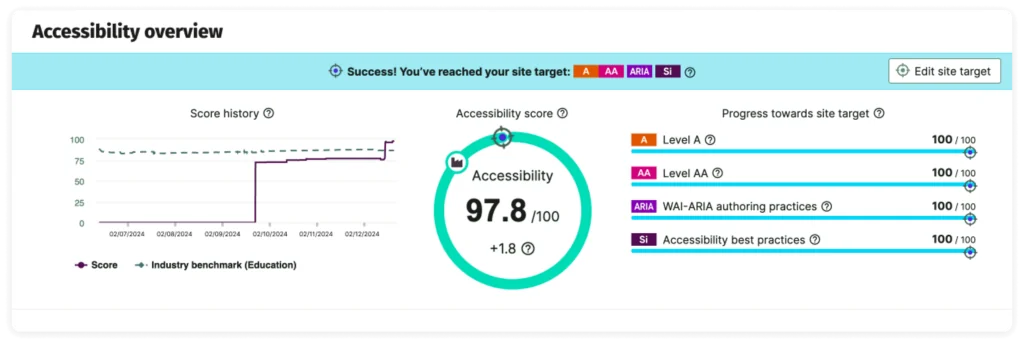case study
Educational Organization
Location
USA
Industry
Education
Background
Our client, an organization in the education sector based in the United States, wanted to improve their website’s accessibility. This initiative was part of their commitment to providing equal access to their services for all users, including those with disabilities.
The Challenge
The client wanted to improve the accessibility of their website on all levels of WCAG (Web Content Accessibility Guidelines) compliance. Achieving this required identifying and resolving issues affecting the site’s usability and compatibility with assistive technologies like screen readers.

The Process
The Audit
The first step in the process was conducting an in-depth accessibility audit of the client’s infrastructure. The initial results weren’t bad, but our client wanted to improve them further. We identified areas that required attention to align with A, AA, and AAA WCAG compliance standards. Utilizing external tools, we identified issues such as line height discrepancies, color contrast failures, and structural inefficiencies in headings.
A Level: Addressing Fundamental Accessibility Issues
To comply with fundamental accessibility standards, we addressed missing text alternatives for images and links, ensuring that all visual content was accessible to users relying on assistive technologies. Duplicate element IDs were corrected, improving the platform’s structure and compatibility with screen readers. The problem with empty headings was resolved by introducing meaningful text while missing ARIA (Accessible Rich Internet Applications) attributes were added to enhance navigability for assistive devices.
AA Level: Enhancing Usability
On the AA level, we resolved issues directly impacting usability, such as text clipping during resizing. This involved refining responsive design parameters to ensure text elements were appropriately scaled without distortion. We also made adjustments to meet minimum contrast thresholds, further improving visual accessibility across the platform.
AAA Level: Optimizing Readability and Customization
On the highest level of compliance, we focused on improving text readability and contrast. Adjustments were made to ensure that line heights met the required minimum values, enhancing the overall accessibility of content. Fixed font sizes were replaced with scalable units, empowering users to adjust text size according to their preferences. Color contrast issues were resolved using a revised palette that adhered to contrast standards.
Improving ARIA Support for Assistive Technologies
To comply with fundamental accessibility standards, we addressed missing text alternatives for images and links, ensuring that all visual content was accessible to users relying on assistive technologies. Duplicate element IDs were corrected, improving the platform’s structure and compatibility with screen readers. The problem with empty headings was resolved by introducing meaningful text while missing ARIA (Accessible Rich Internet Applications) attributes were added to enhance navigability for assistive devices.
Structuring Headings for Better Navigation
Utilizing Siteimprove, we identified issues with the website’s headings. We restructured them to create a logical hierarchy that followed accessibility guidelines. Pages were updated to begin with a level 1 heading, and missing content following headings was added to provide clear and meaningful context. These adjustments not only improved accessibility but also enhanced the overall user experience, making the platform more intuitive and easier to navigate.
What we have achieved

The changes we made resulted in a significant increase in accessibility. We have achieved a 20,6% increase in overall accessibility, which raised the accessibility score to 97,8/100, resulting in an outstandingly accessible website. The most significant improvement, a 46% increase, was accomplished at the highest AAA compliance level.
Changes made on all levels of WCAG compliance ensured that the website was not only more accessible but also enhanced the overall user experience and usability of the platform.

